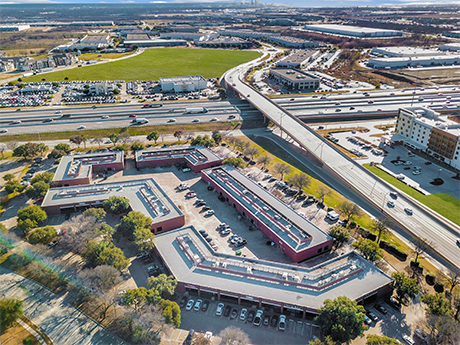Pictured is the Fossil Creek Tech Center, a Class B industrial facility in Fort Worth. Rising costs for new developments make it difficult to grow the supply of spaces like this, which are in high demand throughout Fort Worth as the city experiences strong population growth.
By Jason Baxter, President and CEO, Fort Capital
While some might think industrial warehouses are teeming with e-commerce tenants, in Fort Worth we’ve seen another mix of tenants grow at an even faster rate: service providers. It’s the plumbers, landscapers and electricians who work behind the scenes to keep cities running.
With the skyrocketing population growth in Fort Worth, the industrial space needed by these service providers is also growing at a rapid rate.

Jason Baxter, Fort Capital
According to the latest population estimates from the U.S. Census Bureau, Fort Worth’s population increase was the third largest in the nation between 2019 and 2020, a period during which the city added more than 19,000 new residents. This increase allowed Fort Worth to jump from #13 to #12 in terms of largest US cities based on population.
We often forget that population growth on this scale impacts every facet of real estate – housing, office, entertainment, industrial. Each of these uses requires the maintenance of different types of service providers.
Fort Worth and similar fast-growing markets do not have enough space to support this growing segment of the tenant base in addition to the e-commerce and logistics users who have become the face of industrial real estate.
Global supply chain disruption is only exacerbating this problem, as tenants find it harder to establish occupancy and expansion timelines due to uncertainty about when their supplies and equipment will be available.
At least in Fort Worth, service providers typically occupy Class B industrial buildings, and those assets are depleting and irreplaceable. Due to the high costs of building land, as well as location/zoning restrictions, it is impossible to recreate these types of assets, especially within the city limits.
Where there was a lack of inventory before this surge in population growth, now the industrial market is jam-packed, leaving these service providers no choice but to expand into the county suburbs of Tarrant. This is a temporary solution, because this inventory problem extends to the whole metropolis. Based on this trend, we have extended our search for investment opportunities to these surrounding areas.
The shortfall in supply relative to demand is hardly limited to the Class B segment of the market, however. In many submarkets, industrial asset valuations are at historic highs as tenants seek prime locations from which they can easily service growing populations. Since we began targeting industrial assets in this market in 2015, the scale and speed of the industrial growth story in this city has not escaped our notice.
Works in 2022
In addition to inventory issues, these tenants also face barriers on the service side. In Class B industrial space, we have witnessed a general lack of sophistication in the level of property management that is typically provided.
These assets have always had less sophisticated owners who either chose the cheapest property management service or operated the asset themselves, even if they weren’t equipped to handle the unique challenges of managing the property. class B industrial properties.
Our company has taken care of it first hand. After repeated struggles to identify property management partners who could meet our standards, we created our own property management arm, FCP Management. This branch is dedicated to operating assets with excellence and providing the absolute best service to each of our tenants and partners.
From a technology perspective, the industrial real estate industry has struggled to enter the 21st century, with many tenants still expecting to hand-deliver rent checks each month to their property managers. To facilitate such operational processes, we and other third-party management services have introduced personalized portals through which they can pay rent online, update contact details and even submit maintenance requests leading to faster resolutions.
— This article originally appeared in the June 2022 issue of Texas real estate business magazine.

